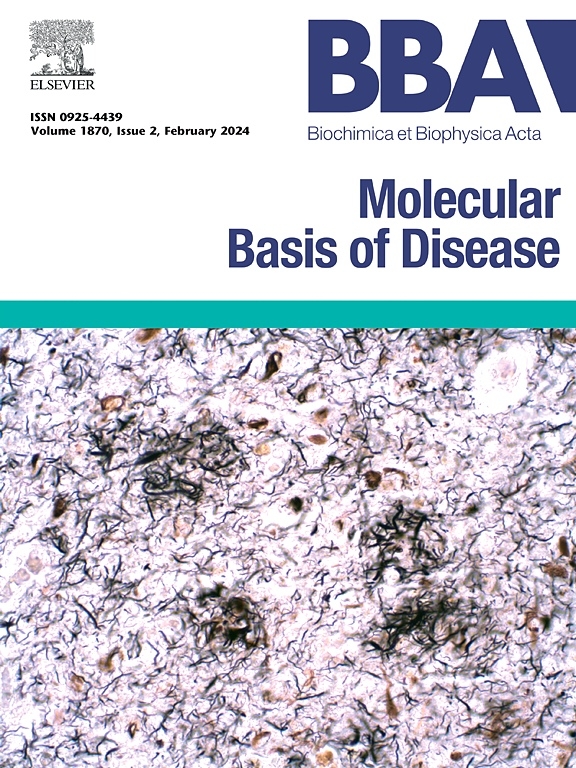循环单核细胞粘附通过激酶3介导的内皮化下游修复内皮剥落损伤。
IF 4.2
2区 生物学
Q2 BIOCHEMISTRY & MOLECULAR BIOLOGY
Biochimica et biophysica acta. Molecular basis of disease
Pub Date : 2024-12-15
DOI:10.1016/j.bbadis.2024.167631
引用次数: 0
摘要
内皮单层的完整性对于防止危及生命的出血和血栓形成至关重要。然而,严重的内皮剥离损伤如何迅速修复仍是未知的。鉴于内皮细胞和循环单核细胞之间的共同生物学特性,我们旨在研究血液单核细胞是否参与内皮细胞伤口愈合。采用钢丝损伤法建立颈总动脉内皮剥脱(CCAED)模型。利用免疫荧光和平行平板流动室评估单核细胞粘附。我们最初观察到,在CCAED模型诱导后,循环单核细胞介导的内皮化在激酶3缺陷小鼠(DOK3-/-)下游比野生型(WT)小鼠更好。快速内皮化增加内皮完整性,防止凝血,减少血栓形成。在机制上,内皮剥离损伤后,单核细胞趋化蛋白1 (MCP1)与DOK3和C-C趋化因子受体2B型(CCR2B)分离,增加细胞内Ca2+浓度,促进循环单核细胞的粘附。然而,这一过程被CCR2B抑制剂INCB3344所抑制。此外,从DOK3-/-小鼠分离的循环单核细胞的粘附功能比WT小鼠强。此外,在WT小鼠中,粘附的单核细胞表达内皮特异性标记物并补偿内皮依赖性血管松弛。同样,这些效果在DOK3-/-小鼠中得到增强。Bindarit是一种选择性MCP1抑制剂,在WT小鼠CCAED手术后抑制内皮化,但在DOK3-/-小鼠中没有。综上所述,循环单核细胞介导的内皮化通过MCP1/DOK3/CCR2B/Ca2+信号修复内皮剥离损伤,补偿内皮功能。我们的研究结果表明,循环单核细胞粘附是一个重要的内皮伤口愈合机制。本文章由计算机程序翻译,如有差异,请以英文原文为准。

Circulating monocyte adhesion repairs endothelium-denuded injury through downstream of kinase 3-mediated endothelialization
The integrity of the endothelial monolayer is critical for preventing life-threatening hemorrhaging and thrombosis. However, how severe endothelium-denuded injury is rapidly repaired remains unknown. Given the common biological properties between endothelial cells and circulating monocytes, we aimed to examine whether blood monocytes are involved in endothelium wound healing. The in vivo common carotid artery endothelium-denuded (CCAED) model was established through a wire-induced injury. Monocyte adhesion was assessed using immunofluorescence and a parallel plate flow chamber. We initially observed that the circulating monocyte-mediated endothelialization was better downstream of kinase 3 deficient mice (DOK3−/−) than that of wild-type (WT) mice following induction of the CCAED model. Rapid endothelialization increased endothelial integrity, prevented coagulation, and decreased thrombosis. Mechanistically, following endothelium-denuded injury, monocyte chemoattractant protein 1 (MCP1) disassociated from DOK3 and C-C chemokine receptor type 2B (CCR2B), increased the intracellular Ca2+ concentration, and promoted adhesion in circulating monocytes. However, this process was inhibited by the CCR2B inhibitor INCB3344. Moreover, the adhesive functions of circulating monocytes isolated from DOK3−/− mice were stronger than those from WT mice. Furthermore, adhered monocytes expressed endothelial-specific markers and compensated for endothelium-dependent vasorelaxation in WT mice. Similarly, these effects were enhanced in DOK3−/− mice. Bindarit, a selective MCP1 inhibitor, suppressed endothelialization following CCAED surgery in WT mice but not in DOK3−/− mice. In conclusion, endothelialization mediated by circulating monocytes repairs endothelium-denuded injury to compensate for endothelial functions through MCP1/DOK3/CCR2B/Ca2+ signaling. Our findings indicate that circulating monocyte adhesion is an important endothelial wound healing mechanism.
求助全文
通过发布文献求助,成功后即可免费获取论文全文。
去求助
来源期刊
CiteScore
12.30
自引率
0.00%
发文量
218
审稿时长
32 days
期刊介绍:
BBA Molecular Basis of Disease addresses the biochemistry and molecular genetics of disease processes and models of human disease. This journal covers aspects of aging, cancer, metabolic-, neurological-, and immunological-based disease. Manuscripts focused on using animal models to elucidate biochemical and mechanistic insight in each of these conditions, are particularly encouraged. Manuscripts should emphasize the underlying mechanisms of disease pathways and provide novel contributions to the understanding and/or treatment of these disorders. Highly descriptive and method development submissions may be declined without full review. The submission of uninvited reviews to BBA - Molecular Basis of Disease is strongly discouraged, and any such uninvited review should be accompanied by a coverletter outlining the compelling reasons why the review should be considered.

 求助内容:
求助内容: 应助结果提醒方式:
应助结果提醒方式:


